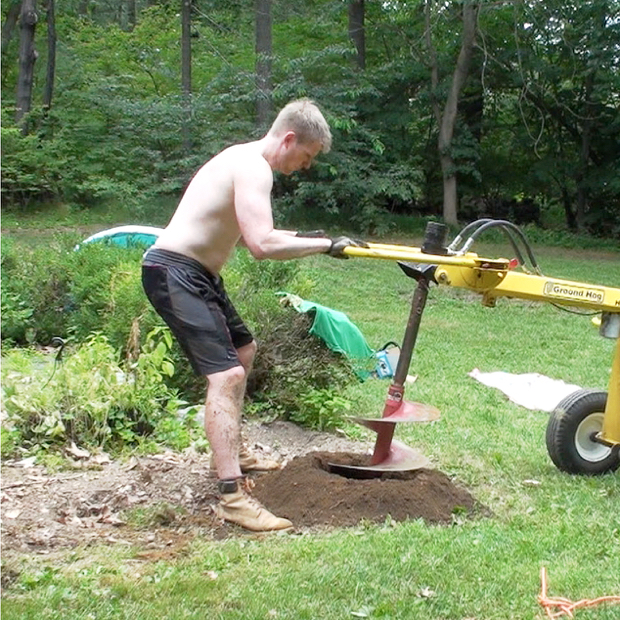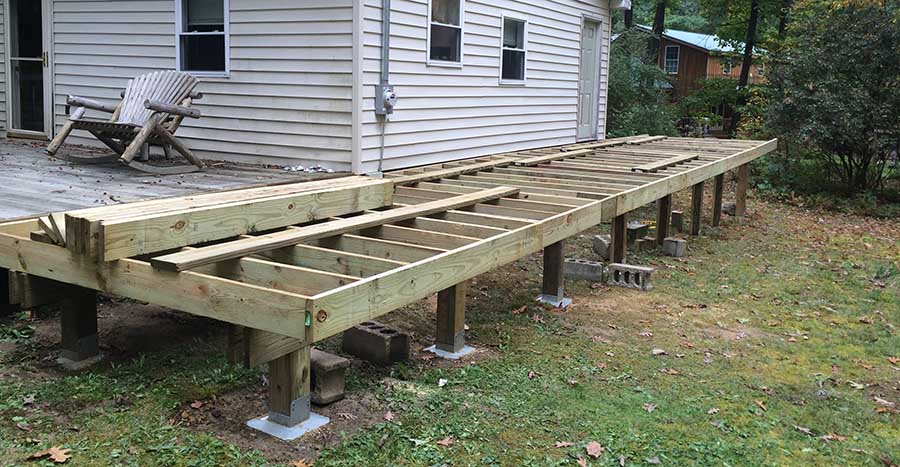Choosing the Right Deck Footings for Stability and Durability
The long life and safety and security of your deck depend greatly on the type of grounds you pick, as they supply the important assistance and security to stand up to the test of time. In this conversation, we will certainly explore the different kinds of deck footings, consider the vital variables to weigh when making a decision, and dig right into the pros and disadvantages of different alternatives.
Sorts Of Deck Footings
These footings consist of a round hole filled up with concrete, which provides a solid structure for the deck posts. Concrete pier grounds are reasonably very easy to mount and provide superb security, making them a popular option for numerous deck projects.
One more kind of ground is the helical stack footing. Helical piles are steel shafts with helical plates affixed to them. These footings are set up by screwing them right into the ground, which produces a secure structure for the deck. Helical pile grounds are ideal for locations with tough dirt conditions, as they can be set up in virtually any kind of kind of dirt. They likewise allow for very easy change and progressing of the deck if required.
Conversely, some home builders select precast concrete grounds. These grounds are made from durable concrete and come in numerous forms and sizes to fit different deck layouts. Precast concrete footings are practical to mount and give a stable base for the deck framework.
Ultimately, another choice is the post-in-anchor ground system. This kind of footing involves driving a metal support into the ground and connecting it to the deck message. It uses versatility in regards to positioning the deck articles and is appropriate for decks with lightweight structures.
When picking the ideal kind of deck footing, it is crucial to take into consideration aspects such as soil conditions, deck lots, and local building ordinance (Deck Footings). Consulting with a specialist contractor or architectural designer can help ensure the proper ground is picked for a stable and risk-free deck
Elements to Consider When Selecting Footings
When selecting the appropriate grounds for a deck, it is important to carefully think about numerous elements such as soil conditions, deck lots, and adherence to local building codes. These factors play a significant role in ensuring the security and durability of the deck framework.
Among the key factors to think about is the soil conditions. The sort of dirt on which the deck will be constructed establishes the sort of footings needed. Decks constructed on sandy or loose dirts may need much deeper grounds to offer adequate assistance and protect against settling. On the various other hand, decks constructed on clay or large dirts might require grounds that can fit the dirt's propensity to increase and contract.
One more important variable is the deck lots. The weight of the deck, including the materials made use of and any kind of possible live loads such as furniture or celebrations, should be taken into account when choosing footings. The footings should be developed to birth the weight of the deck and distribute it evenly to protect against any type of structural concerns or failings.
Lastly, adherence to local structure codes is extremely important. Structure codes differ from region to region, and it is vital to follow the details demands established by the local authorities. Deck Footings. These codes ensure that the deck is built securely and fulfills the essential requirements for structural honesty and load-bearing capacity
Concrete Grounds: Disadvantages and pros

Concrete grounds offer several advantages and drawbacks when used as the foundation for a deck. On the positive side, concrete footings give outstanding security and sturdiness. Concrete is a inflexible and strong product that can support hefty lots and stand up to numerous weather. It likewise has a lengthy life expectancy, making it a reliable choice for long-lasting use.
One more advantage of concrete footings is their adaptability. They can be poured into various shapes and sizes to accommodate different deck layouts and arrangements. Concrete grounds can be tailored to fit the specific requirements and demands of the deck framework.
Nevertheless, there are also some disadvantages to using concrete footings. One major downside is the price and labor associated with their installment. Concrete grounds require excavation and often need the support of heavy equipment. This can raise the overall expense of the deck task and may require professional assistance.

Helical Piers Vs. Sonotubes: Which Is Much better?
In taking into consideration the structure alternatives for a deck, the contrast in between helical piers and sonotubes is important in figuring out the remarkable option. They are twisted into the ground utilizing hydraulic machinery, supplying a durable and secure structure for the deck.
When it involves stability and resilience, helical piers have the upper hand. The helical plates on the piers develop a strong hold with the dirt, moving or stopping any kind of movement of the deck. This is especially valuable in locations with unstable or shifting soil conditions. Sonotubes, on the other hand, depend only on the concrete filling up for security, which might not use the exact same degree of strength and resistance.
In regards to setup, helical piers are fairly easier and faster to install contrasted to sonotubes. The hydraulic equipment used to twist the piers right into the ground makes sure a quick and effective procedure. Sonotubes, on the other hand, require excavating openings and putting straight from the source concrete, which can be labor-intensive and taxing.
Additionally, helical piers are an even more flexible alternative. They can be utilized in numerous soil problems and can be changed or enhanced if required. Sonotubes, on the various other hand, may call for additional support, such as rebar, in certain soil problems or locations with high tons needs.
Picking the Right Footings for Your Deck's Measurements
For optimum structural integrity, it is important to meticulously pick the proper click here for info footings that align with the measurements of your deck. The dimensions of your deck, including its size, elevation, and size, play a significant duty in figuring out the kind and size of footings required.
When choosing footings for your deck, it is very important to consider the load-bearing capacity of the soil. The weight of the deck, combined with the weight of any kind of furniture or people on it, applies a considerable force on the footings (Deck Footings). As a result, it is vital to pick grounds that can properly support this weight without changing or sinking in time.
Bigger decks with higher measurements need larger grounds to supply adequate security and support. The form of the footings, whether they are square or rounded, depends on the layout and design of the deck.
Final Thought
Finally, picking the right deck grounds is important for making certain security and resilience. Variables such as the type of footings, the deck's dimensions, and the benefits and drawbacks of various choices need to be thought about. Concrete footings use strength and durability, but might be a lot more costly and lengthy to set up. Helical piers and sonotubes have their own advantages and you could try these out disadvantages. Eventually, picking the appropriate grounds for your deck's specific demands is crucial for a successful and lasting framework.
These footings are composed of a round opening loaded with concrete, which supplies a solid foundation for the deck messages. Concrete pier footings are relatively very easy to mount and offer exceptional security, making them a preferred selection for numerous deck projects.
Precast concrete footings are hassle-free to set up and offer a steady base for the deck framework.
It uses flexibility in terms of placing the deck messages and is ideal for decks with lightweight structures.
Concrete grounds offer numerous advantages and drawbacks when used as the structure for a deck.